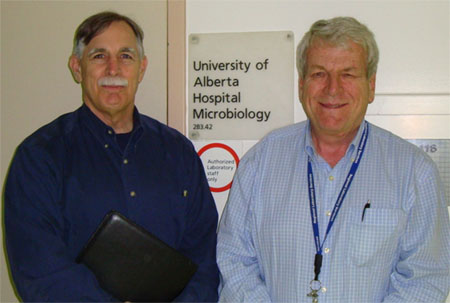Pathologists and medical lab managers regularly challenged to provide high-quality cost-effective services with limited resources.
DATELINE: EDMONTON, ALBERTA, CANADA—Over the past decade and a half, this economically-prosperous province has re-aligned its healthcare regional bodies more than once in an effort to control costs while supporting clinical services that meet the expectations of its patients. In some cases, these realignments have subjected Alberta’s clinical laboratories to deep changes in their reporting structure and operational make-up.
Your Dark Daily editor was in Edmonton last week and had the opportunity to visit the Department of Laboratory Medicine and Pathology at the University of Alberta Hospital (UAH). The laboratory facility encompasses four different floors of one wing of the over 800 bed facility. It is the location of one of the two Provincial Laboratories for Public Health in Alberta and includes UAH’s Division of Medical Microbiology.
“Our clinical laboratory performs about 4.3 million tests per year,” stated Dr. Robert Rennie, Ph.D., FCCM, D (ABMM), one of the hosts of the lab tour. “We provide full-testing services for our hospital, and handle reference laboratory testing for other Alberta Health zones. Our lab also performs reference testing in support of laboratories in other provinces in Western Canada.” Dr. Rennie is the Zone Clinical Department Head for Alberta Health Services (AHS) Laboratory Services in the Edmonton Zone.
“Our laboratory is organized to serve multiple missions, even here at this hospital campus,” continued Dr. Rennie. “The University of Alberta Hospital is a tertiary care center, a teaching hospital, and a research center. It has a children’s hospital (Stollery Children’s Hospital) embedded within the facility.
“Our extensive test menu supports this wide range of clinical, teaching, and research activity,” he stated. “Because of our teaching responsibilities, we have expertise in laboratory medicine that gives us a broad base of skills.”

In Edmonton, at the University of Alberta Department of Pathology and Clinical Laboratory Services (from left): Robert L. Michel, Editor of Dark Daily; and Dr. Robert Rennie, Ph.D., Clinical Department Head.
It was in mid-2008, when the Minister of Health and Wellness announced the latest major restructuring of the province’s health system. It combined the existing 12 health regions into a single unified organization, and recognized five zones that would provide healthcare services to the province’s 3.7 million residents.
One of Two Major Clinical Laboratories in Edmonton Area
“The Edmonton zone serves approximately 1.4 million people,” noted Shelley Rawlake, MLT, ART, CRSP, who is Executive Director for AHS Laboratory Services for the Edmonton Area, and Provincial Programs (Provincial Laboratory of Public Health and Genetic Laboratory Services). Ms. Rawlake was co-host of the lab tour. “Our laboratory here at the University of Alberta Hospital is one of the two largest medical laboratory organizations in our zone.”
“The second primary laboratory organization in the Edmonton zone is a private commercial laboratory company,” added Ms. Rawlake. “Back in the mid-1990s, major restructuring in the Edmonton area resulted in the consolidation of all the private independent laboratories that operated in Edmonton. This consolidation eventually led to the formation of a single private laboratory company. Since that date, this laboratory firm has worked closely with Alberta Health Service in central and northern Alberta to help deliver diagnostic services in some AHS facilities, conduct community-based testing, and provide collection and transportation services between AHS sites.”
Finding Enough Medical Laboratory Professionals
Many Dark Daily readers may wonder about the availability of medical laboratory technologists (MLT), laboratory assistants, pathologists and clinical laboratory scientists (CLS) in this region of Canada. In Edmonton, Dr. Rennie stated that the laboratory has had difficulty maintaining adequate numbers of staff to handle increasing workloads.
“Like most laboratories in Canada and the United States, the average age of our staff is over 50 years old,” noted Dr. Rennie. “It will be our most experienced lab professionals who retire, and we want to develop succession plans that help us capture their institutional knowledge in a way that can be shared with the younger laboratory professionals working here.”
Many of the healthcare trends and issues in Alberta will be familiar to pathologists and clinical laboratory managers in other developed nations. Across the province, the incidences of chronic disease increase from year to year. Population demographics in Alberta mean that the number of citizens turning 65 each year will begin to increase. A substantial number of pathologists and skilled laboratory professionals who are in this age group will soon become eligible for retirement in growing numbers.
Thus, the critical issue for laboratory professionals in Alberta is how to accommodate the increased utilization of clinical laboratory tests by physicians, who themselves are struggling to cope with growing numbers of patients who present with serious diseases. All this must be accomplished even as the provincial health system is seeking to get better identification of the costs of pathology and medical laboratory testing services.
Over the years, Dark Daily and The Dark Report have identified Alberta as one of the world’s more progressive government health programs. The Alberta health system has demonstrated its willingness to regularly shake up the status quo with substantial cutbacks in funding and with reorganizations. These actions are designed to motivate hospitals, physicians, and clinical laboratories to innovate in ways that improve patient care.
For this reason, healthcare in Alberta is a story worth watching. The site visit to the laboratory at the University of Alberta Hospital was a valuable learning experience and will help your Dark Daily editor better understand the unfolding events in the Province of Alberta.
Finally, thanks to all of the folks in Edmonton who helped make this site visit possible.
Your Dark Daily Editor
E-mail: rmichel@darkreport.com with your comments.
Related Information:
Laboratory Services – University of Alberta Hospital
University of Alberta, Department of Pathology and Laboratory Medicine
Lab Services in Alberta Undergo Radical Changes (The Dark Report, January 6, 1997)



